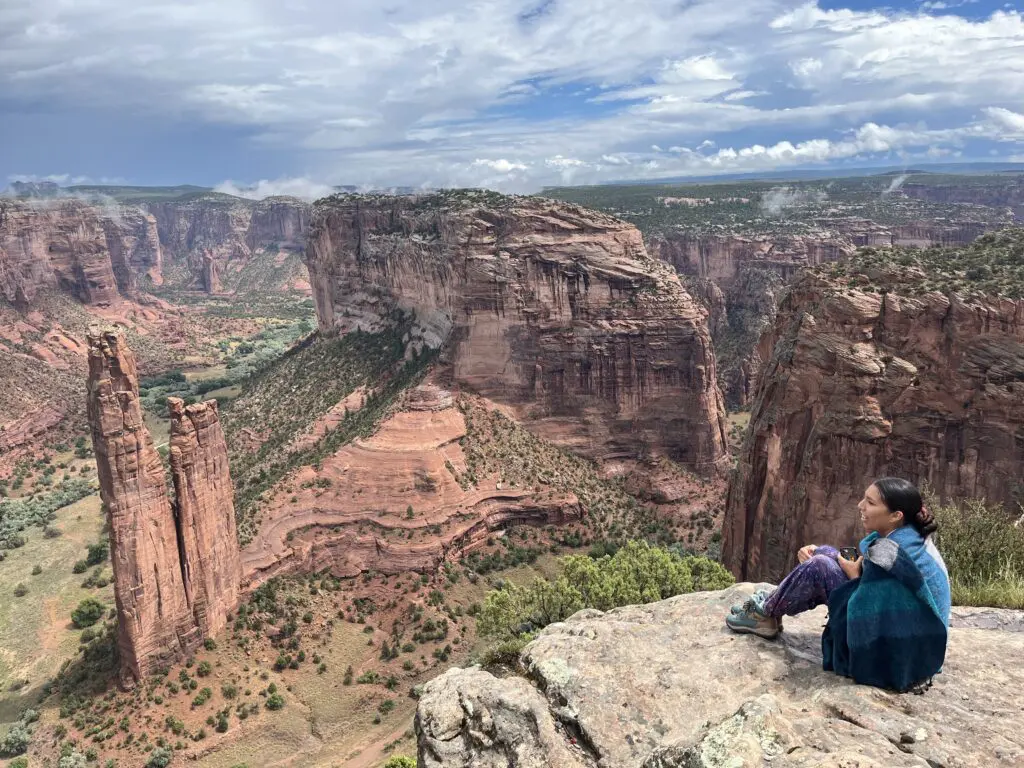Black Mesa Exchange

From August 16th to the 24th, 2024, the Black Mesa to Catskills Exchange Program began the second half of the exchange program on Black Mesa. Unlike the Catskills visit, the Black Mesa Exchange was only a weeklong but filled with something new everyday. Iris Gillingham of Gael Roots Community Farm and Olivia (Liv) Bigtree, Oneida from the Onondaga Nation traveled from their homes in New York to Phoenix, Arizona on Friday. Exchange program Diné participant Raina Silver picked up Iris and Liv and stopped at a small stream in Wet Beaver Creek. where they were introduced to the environment and land. Upon arrival in Kinłání (Flagstaff, AZ), Iris, Liv, and Raina joined Exchange Program co-lead Raeanna (Annie) Johnson and Tó Nizhóní Ání at Flagstaff High School. That evening, the Apache Stronghold Prayer Journey had made their stop at the local school under Dookʼoʼoosłííd or Dził Chu, also known as the San Francisco Peaks. At the time, they were on their way to Washington, D.C., to appeal to the United States Supreme Court to protect Chi’chil Biłdagoteel (Oak Flat).
The significance of the sacred mountain, Dookʼoʼoosłííd aka the San Francisco Peaks, and the ongoing fight against reclaimed water use for the ski resort was shared by Flagstaff High School Native American Club and Youth, along with various Indigenous organizations of northern Arizona. This visit represented mutual support and the shared importance of protecting the sacred. The exchange participants departed early Saturday morning to Black Mesa to settle into their new space for the week. Two hours later, the crew arrived at Tsé Bik’i Na’astélí (Rock with Petroglyphs) near Raeanna’s family ranch, Two Strikes Ranch. Raeanna’s dad, Marshall Johnson, prepared a fire for a sweat lodge. This provided a grounding introduction for the exchange crew to the land and family.

Sunday morning began early with a sheep butchering demonstration and introduction, followed by a cinch-making workshop with Hard Rock Chapter’s President Jay Begaye Jr. Participants learned how to string the cinch by looping the cordage material back and forth from each ring. At the end of the workshop, five sets of prepared warped cinches were made, and the weaving process began. This project gave participants the opportunity to work with Navajo Churro wool and learn Diné weaving techniques. To kick off the week participants met and collaborated with the Tó Nizhóní Ání Food Sovereignty Program Coordinator, Audrey Narindrankura, and a few of her crew members on Monday. Audrey explained the Food Sovereignty program’s projects to the exchange participants while they helped pick corn from a field, she and her work crew planted and worked on. The harvested corn was prepared into Nitsidigo’i’, a traditional Diné food with others from the community. While husking, the silks and some of the husks are saved for ceremonial use. The kernels are then cut from the cob and ground to create a puree consistency. This was then scooped into the center of the husk and folded before being baked.

On Tuesday, exchange program participants attended the second and last cinch-making workshop with Jay Begaye Jr. Significant progress was made on the cinch belt; however, the belts were not finished by the end of the session. Jay allowed participants to continue using his supplies and tools for the next few days. As the week progressed participants joined the Tó Nizhóní Ání Watershed Restoration and the Food Sovereignty work crews on Wednesday for a Seed Pellet-Making Workshop at the Rezduro Venue in Hardrock, AZ. The seed pellets made from the workshop were used by the restoration project for erosion control and reinforcement. The seed mixture consisted of native grass to the area. Seeds from mountain tobacco, a ceremonial plant, were also included in the pellet mix. Andrew Atencia, community organizer with Tó Nizhóní Ání and the Watershed Restoration Project lead, took the workshop participants out into the fields to showcase the making of one-rock dams and weirs and how to implement the seed pellets.

The following day, exchange participants had the opportunity to visit the vast and beautiful Canyon de Chelly National Monument in Chinle, AZ to learn about the ecological and agricultural landscape. Participants saw ancient dwellings that scatter throughout the canyon and observed how the impact of water shaped this desert landscape. In one location, looking at the unique rock outpost in the canyon, Annie shared the story about Spider Rock and how Diné people learned to weave. This trip displayed the diverse biomes and ecological landscapes of not only Arizona but also Diné Bikéyah. Marshall taught a mini horsemanship workshop on the last morning of the Black Mesa Exchange Program. Iris and Liv learned about saddling, riding, and working with horses. The experience was a beautiful way to end the time on Two Strikes Ranch on Black Mesa. Before departing for Phoenix, AZ, the exchange program participants volunteered at the Rezduro 2024 event, the first Indigenous-led mountain bike enduro race which concluded the Black Mesa immersion portion of the Black Mesa to Catskills Exchange Program.
The exchange participants are very grateful for all the support and hands in making this program possible. They had the privilege of learning about significant traditional knowledge and Indigenous cultures from many incredible people. The Exchange Program participants thank the Building Equity and Alignment for Environmental Justice (BEA) Fund for making this exchange program possible. For more information on this exchange program, email Raeanna@tonizhoniani.org





